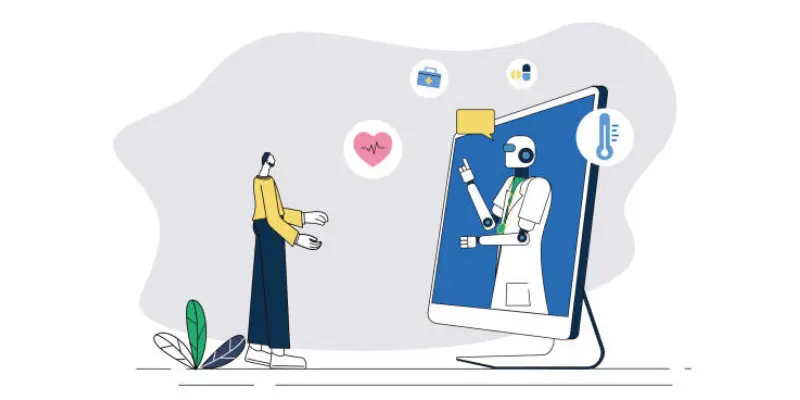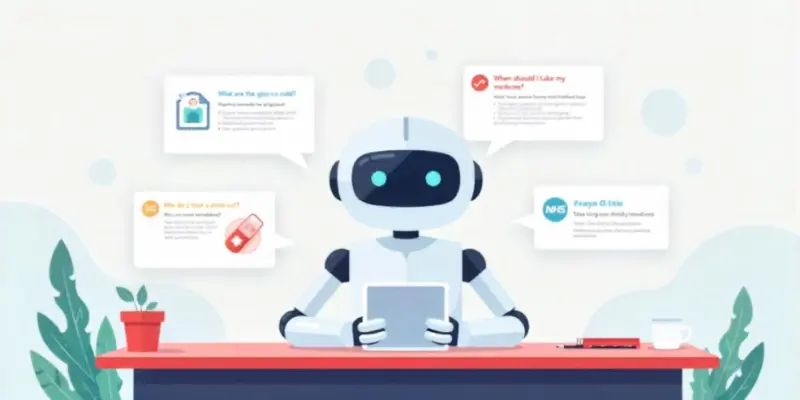How to Build an AI Healthcare Chatbot From Scratch
Published: 19 Apr 2025
Have you ever wondered how those smart healthcare chatbots actually work? They seem so advanced but in actual they are quite simple. Building an AI chatbot is very easy and can be done in a few steps. If you are curious (and maybe a little confused) about where to even begin, don’t worry. This article will show you exactly how to build an AI healthcare chatbot from scratch—even if you have never tried to build one before.

Understand the Basics Before You Start
Before building your AI healthcare chatbot, it’s important to know what it does and how it works. Don’t worry, this part is easy to understand.
What Does an AI Chatbot Do in Healthcare?
An AI chatbot is a smart assistant that helps people with their health. It talks to users like a real person and gives useful suggestions and assists them in medical queries.
Here are some common things it can do:
- Answer health questions like “What are the symptoms of the flu?”
- Remind patients to take their medicine on time
- Book doctor appointments without being lined in the clinics
- Share health tips like “Drink more water” or “Get enough sleep”
💬 Example: A patient types, “I have a fever and cough. What should I do?”
The chatbot replies, “You might have a viral infection. Please drink fluids and rest. If symptoms get worse, see a doctor.”
How Does It Work?
Let’s keep it basic. Here’s how a healthcare chatbot works:
- The user types a question.
- The chatbot reads the question and understands the words.
- AI finds the best answer.
- The chatbot replies in a friendly way.
It’s like a smart text buddy that knows a lot about health.
Tools You’ll Need
You do not need to be an expert to start. But you do need a few tools.
Here’s a simple list:
- Programming Language:
Use Python. It’s easy and perfect for beginners. - AI Platform:
Pick one of these AI platforms, all are simple.- OpenAI (ChatGPT API): Great for human-like conversations with best prompts
- Dialogflow: Easy setup and works with voice
- Rasa: More control, good for advanced users
- OpenAI (ChatGPT API): Great for human-like conversations with best prompts
- Database:
To store questions, answers and patient data (if needed) - Frontend (Optional):
A simple website or app where users chat with the bot
💡 Tip: Start with free versions of these tools. You can upgrade later.
Step by Step Guide to Build It from Scratch
Now that you know the basics, it’s time to build your own AI healthcare chatbot. Don’t worry, it’s easier than you think. Follow these simple steps and you will have your first chatbot ready in no time.
Step 1: Plan Your Chatbot’s Role
The first step is to capture a problem that you will be willing the chatbot to answer. Before you build anything, ask yourself:
- What do you want the chatbot to do?
- Who will use it? (Patients? Nurses? Caregivers?)
- What kind of help will it offer?
Keep it simple in the beginning.
💬 Example: Your chatbot could remind older patients to take their medicine every day. That’s a great place to start.

Step 2: Gather Common Health Questions
Now think about what people will ask the chatbot. Collect simple and useful health related questions. You can use websites like NHS, UK and mayo clinic.
Some examples of common healthcare questions are:
- “What are the signs of a cold?”
- “When should I take my medicine?”
- “How do I treat a minor cut?”
Put these questions into a list. Then write short and helpful answers for each.
💡 Tip: You can get ideas from trusted health websites like Mayo Clinic or NHS.

Step 3: Choose an AI Tool
This is the brain of your chatbot. You will need an AI platform that understands questions and gives smart answers. You will integrate the API of these AI tools at the backend of your chatbots’ interface.
Here are 3 easy options:
- OpenAI (ChatGPT API): Great for natural conversations
- Dialogflow: Simple setup and connects with apps like WhatsApp
- Rasa: Good if you want to build everything on your own
📌 Best choice for beginners? Dialogflow or ChatGPT API which are easy to learn and quick to use.

Also Read: AI as Caregiver in Healthcare
Step 4: Train Your Chatbot
Now it’s time to teach your chatbot how to respond. This is the most important step in building an AI chatbot for healthcare. you will do this very carefully and add al the necessary questions that you gathered.
Do this in a few simple steps:
- Add your questions (these are called “intents”)
- Link each question to a reply
- Add multiple similar phrases so your bot understands more ways to ask the same thing
- Create fallback replies like: “Sorry, I didn’t get that. Please try again.”
💬 Example:
Intent: “What are flu symptoms?”
Reply: “Common flu symptoms include fever, chills, cough and sore throat.”

Step 5: Build a Simple Interface
Now your chatbot needs a face. A place where people can chat. You can design it on your own but a simple interface is necessary for a professional look.
You can:
- Use a website
- Add it to a mobile app
- Connect it to WhatsApp, Facebook Messenger or Telegram
💡 Tip: If you are not a web developer, try tools like Tidio, Landbot or Botpress to make things easier.

Step 6: Test and Improve
You are almost done! But first, you need to test your chatbot. Give this step maximum time you can by checking questions answers from the user’s point of view.
Use different phrases to ask:
- Simple health questions
- Weird or misspelled words
- Unrelated things (to see how it reacts)
Ask your friends or family to test it too. See what works and what doesn’t.
Then go back and fix the mistakes if it happens.
💬 Example: If your bot replies “I don’t understand” too often, you may need to add more examples in training.

After careful testing and approval from an AI company, Now your chatbot is ready to help real people. Start small, improve often and keep learning. In the next section, we are going to discuss some common mistakes that can cause some real problems for your own project.
Also Read: AI Chatbot Projects in Healthcare For Students
Common Mistakes to Avoid
When building your first AI healthcare chatbot, it’s common to make a few mistakes. But don’t worry, we will help you spot them before they happen. Following are some common errors and details on how to fix them.

Trying to Do Too Much at Once
You don’t need to build the perfect chatbot on day one. Many beginners try to add too many features at the start and become frustrated with the repeated mistakes. That leads give up in early stages
💡 Fix it:
Start small. Pick one use case like reminders or symptom checking. Build that first. Add more later.
Using Complicated Medical Terms
Remember, your users may not understand medical words like “bronchospasm” or “hypertension.” If your chatbot talks like a textbook, people will stop using it. So always use beginner friendly wording while training your chatbot.
💡 Fix it:
Use simple words. Explain medical terms in plain language.
Example: Instead of saying “You may have acute rhinitis,” say “You might have a common cold.”
Ignoring Privacy and Data Rules
If your chatbot asks users for personal info like names or health symptoms, you must protect that data. Forgetting this can cause legal trouble.
💡 Fix it:
Always tell users how their data is stored. Use safe tools. Don’t collect private info unless you really need it.
Tip: Look into basic privacy rules like HIPAA (USA) or GDPR (Europe) if your chatbot handles patient data.
Skipping the Testing Step
Many people forget to test their chatbot before launching it. But even a small bug can make your chatbot give wrong answers or stop working in the real world.
💡 Fix it:
Test everything. Ask different types of questions. Try weird spellings or short replies. Fix anything that breaks.
Example: Instead of typing “I have a cold,” try “I feel sniffly” or “nose hurts” and see if your bot still gives a good answer.
Forgetting to Update the Bot
Health advice changes over time. If your chatbot gives old or wrong information, users might lose trust. This update might include the fixings of errors users might be facing while interacting with your chatbot.
💡 Fix it:
Check your chatbot’s answers every few months. Keep them fresh and correct.
Tip: Set a reminder to review your bot content regularly, just like updating a blog.
Making It Sound Like a Robot
If your chatbot sounds cold or stiff, users would not enjoy chatting with it. Even in healthcare, people want kindness.
💡 Fix it:
Use a friendly tone. Add emojis or soft words like humans.
Example:
❌ “Invalid input. Try again.”
✅ “Oops! I didn’t catch that. Can you ask me in a different way? 😊”
Real-Life Examples to Inspire You
Before you finish your chatbot, let’s take a quick look at some real healthcare chatbots already helping people. These examples can give you new ideas and maybe even spark your next big project!
Florence– The Health Reminder Buddy
Florence is like a friendly nurse on your phone. It reminds users to take medicine, drink water and stay healthy.
How it helps:
- Sends gentle daily reminders
- Tracks health habits (like exercise or steps)
- Shares health tips in simple language
Why it’s great:
It’s super easy to use, perfect for older adults or busy patients who forget things.
👉 Inspiration: You can build a simple version of Florence that sends text messages or app alerts to remind users about their medicine or doctor visits.
Babylon Health – Chat + Video Doctor App
Babylon Health is a smart chatbot that checks symptoms and connects users to real doctors. It uses virtual reality tech to connect users with the doctors.
How it helps:
- Asks about symptoms
- Gives basic advice
- Books a video call with a doctor if needed
Why it’s great:
It saves time. People can talk to a doctor from home instead of waiting at clinics.
👉 Inspiration: You can start by building a chatbot that checks common symptoms and suggests what to do next (like “Drink fluids” or “Call your doctor”).
Ada – Understand Your Symptoms
Ada is a chatbot that works like a digital health checker. It asks users how they feel and helps them figure out possible causes.
How it helps:
- Asks detailed questions
- Uses AI to match symptoms with possible conditions
- Gives clear next steps (see a doctor, rest, take medicine, etc.)
Why it’s great:
It makes health info simple and less scary, even when people don’t know what’s wrong.
👉 Inspiration: You can create a small version of Ada that helps users understand if they should rest at home or go to a clinic.
Suggested Article: How to Boost Your Career in Healthcare AI
Bonus Tip: Pick One Idea and Start Small
These tools took years to build. Don’t try to copy them all at once. Pick one simple feature like reminders or symptom help and focus on that.
🎯 Example: Want to build a chatbot that helps kids with asthma? Start with questions like:
- “What should I do if I’m wheezing?”
- “Can I go outside today?”
Then add more features later.
Conclusion
Building an AI healthcare chatbot might sound tough but now you know it’s not. You don’t need to be a coding expert. You just need a plan, the right tools and a clear goal.
Let’s quickly go over what you have learned:
- You know what a healthcare chatbot is and why it matters.
- You have seen what tools to use and how to train your bot.
- You learned from real examples and spotted the common mistakes to avoid.
Now it’s your turn.
Start with something small. Maybe a chatbot that gives daily health tips. Or one that reminds people to take their medicine. You will learn as you go and improve along the way.
💬 Got an idea for your chatbot already? Write it down and take the first step today.
FAQs About Building Healthcare AI Chatbots
Here are frequently asked questions–answered about how to build an healthcare AI Chatbot;
No, you don’t need to be an expert programmer. Basic knowledge of Python is helpful but platforms like Dialogflow offer user-friendly interfaces that require minimal coding. You can start with templates and tutorials designed for beginners.
Many AI platforms offer free trials that are perfect for beginners creating their first chatbot. You can build a simple healthcare chatbot for free using Dialogflow or Rasa, only upgrading when you need more advanced features or higher usage limits. Costs typically increase based on the number of users and complexity of features.
Source your content from reputable medical websites like Mayo Clinic or WHO. Have healthcare professionals review your chatbot’s responses for accuracy before launch. Remember to include disclaimers that the chatbot isn’t a replacement for professional medical advice.
A basic healthcare chatbot with limited functionality can be built in 1-2 weeks. More complex features like symptom checking might take an additional 2-4 weeks to implement properly. The learning curve is steepest at the beginning but gets easier as you gain experience.
Rule-based chatbots follow predefined paths and can only respond to specific phrases exactly as programmed. AI-powered chatbots use machine learning to understand variations in language and improve over time. AI chatbots generally provide a more natural conversation experience but require more data to train effectively.
Never store personal health information unless absolutely necessary and properly secured. Use encryption for any sensitive data both in transit and at rest. Always include clear privacy policies explaining what data you collect and how you use it.
Yes, chatbots can integrate with existing healthcare systems through APIs. Most modern healthcare platforms offer integration capabilities that allow your chatbot to check schedules or book appointments. Start with simpler integrations and add more complex ones as you become more comfortable with development.
Create a test plan covering common user scenarios and edge cases to ensure comprehensive coverage. Ask people unfamiliar with your project to interact with the chatbot and provide feedback. Track and analyze where conversations break down to continuously improve your bot’s responses.
Healthcare chatbots often fail because they try to handle too many complex medical scenarios without adequate training data. Another common reason is poor conversation design that frustrates users when the bot doesn’t understand their questions. Starting simple and focusing on one specific use case increases your chances of success.
Use conversational language that feels friendly and compassionate rather than clinical or technical. Include occasional gentle humor where appropriate (but never about serious medical conditions). Personalize interactions by remembering user preferences and referencing previous conversations when relevant.





